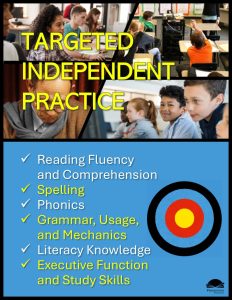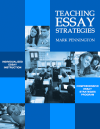
Targeted Independent Practice
Download these FREE Diagnostic Reading and ELA Assessments.
Teachers at all grade levels need diagnostic assessments to determine what students know and what they do not know. Following are FREE comprehensive reading and English-language arts assessments with corresponding recording matrices to provide the data teachers need to target instruction. Designed to be both comprehensive (no random samples) and teacher-friendly with audio files, self-correcting Google forms and sheets (or print versions), teachers have found the data to reliably inform instructional decision-making.
Scroll though to read the research basis, why the assessments are free to use, and the compilation history (if you wish), and download any or all of the FREE Diagnostic Reading and ELA Assessments. Visit the Pennington Publishing store to check out corresponding program resources.
FREE Diagnostic Reading and ELA Assessments (Click links to download and print.)
Phonics Assessments
The phonics assessments feature nonsense words and test all common sound-spellings.
Vowel Sounds Phonics Assessment
Print, Google Forms, Google Sheets and 10:42 Audio File
Consonant Sounds Phonics Assessment
Print, Google Forms, Google Sheets and 12:07 Audio File
Fluency Assessment
The fluency assessment is designed in a tiered reading level format, beginning at the first grade level and proceeding to the seventh grade level. This assessment is individually administered and is timed for two minutes.
Pets Fluency Assessment
Print
Diagnostic Spelling Assessments
Most common spelling patterns are included in this assessment. Administer part or all of the Diagnostic Spelling Assessment (American English Version) test items, according to grade-level criteria.
- Grade 3: K-2 spelling patterns (#s 1‒41)
- Grade 4: K-3 spelling patterns (#s 1‒55)
- Grade 5: K-4 spelling patterns (#s 1‒64)
- Grade 6: K-5 spelling patterns (#s 1‒82)
- Grade 7: K-6 spelling patterns (#s 1‒100)
- Grade 8: K-7 spelling patterns(#s 1‒102)
Most common spelling patterns are included in this assessment. Administer part or all of the Diagnostic Spelling Assessment (Canadian English Version) test items, according to grade-level criteria
- Grade 3: K-2 spelling patterns (#s 1‒41)
- Grade 4: K-3 spelling patterns (#s 1‒55)
- Grade 5: K-4 spelling patterns (#s 1‒64)
- Grade 6: K-5 spelling patterns (#s 1‒82)
- Grade 7: K-6 spelling patterns (#s 1‒100)
- Grade 8: K-7 spelling patterns(#s 1‒106)
Diagnostic American English Spelling Assessment: Print Assessment with “Normal speed” 22:38 and “Quick version 17:26 audio file links. Recording Matrix for Progress Monitoring
Diagnostic Canadian English Spelling Assessment: Print Assessment with “Normal speed” 18:53 and “Quick version 21:12 audio file links. Recording Matrix for Progress Monitoring
Grammar, Usage, and Mechanics Assessments
Use this 45 grammar and usage item assessment to determine student’s knowledge of parts of speech, subjects and predicates, types of sentences, fragments and run-ons, pronoun usage, modifiers, verb tenses and verb forms.
Grammar and Usage Assessment
Print and Google Forms
Use this 32 item mechanics assessment to test students’ ability to apply correct usage of commas, capitalization, and all other essential punctuation.
Mechanics Assessment
As an option, the grammar, usage, and mechanics assessments are combined as a Google form.
Print and Google Forms
Diagnostic Grammar, Usage, and Mechanics Assessment (self-correcting Google forms)
Vocabulary Assessments
The Tier 2 academic language vocabulary has been derived from the research-based Academic Word List (AWL). The Academic Word List (Coxhead) has been ordered into grade level lists by frequency. Each grades 4, 5, 6, 7, and 8 Academic Language Assessment includes 56 Tier 2 words. The Tier 2 words are the academic language words that are most-often generalizable across the academic domains. For example, the word analyze is used in English-language arts, social science, history, science, math, and the arts.
Diagnostic Academic Language Assessments Grades 4, 5, 6, 7, and 8 (self-correcting Google forms)
Data Recording Matrices
Diagnostic Assessment Matrices
*****
Executive Function and Study Skills Self-Assessment and Mastery Matrix
This 56-item assessment includes questions on motivation, spelling, grammar, mechanics, essay writing, memorization strategies, test-preparation and test-taking skills, reading strategies and skills, time management, active listening, organization, best research practices, and note-taking. Each item is keyed to specific lessons in the author’s Essential Study Skills and Targeted Independent Practice: Executive Function and Study Skills programs.
Literacy Knowledge Self-Assessment and Mastery Matrix
This 85-word assessment includes questions on 20 narrative/sensory descriptive genres, language structures, literary elements, literary and poetic devices. Includes a mastery matrix. Each item is keyed to specific lessons in the author’s Targeted Independent Practice: Literacy Knowledge program.
Phonemic Awareness Assessments
Use these five phonemic awareness to determine reading readiness. Each of the 5 assessments is administered whole class and includes audio files.
Syllable Awareness Assessment
Print and 5:48 Audio File
Syllable Rhyming Assessment
Print and 5:38 Audio File
Phonemic Isolation Assessment
Print and 5:54 Audio File
Phonemic Blending Assessment
Print and 5:53 Audio File
Phonemic Segmenting Assessment
Print and 5:21 Audio File
Alphabetic Awareness Assessments
Print and Alphabet Cards
Heart Words Assessments
This 108-word assessment tests student knowledge of high frequency words with an irregular sound-spelling (the part to learn by heart). As an option, teachers may require students to identify the irregular sound spellings by drawing hearts.
Heart Words Assessment
Print
*****
ARE THESE DIAGRNOSTIC ASSESSMENTS RESEARCH-BASED? These are teacher/reading specialist-created comprehensive diagnostics. None are normed. You won’t find them on What Works… As you probably know, comprehensive diagnostics need not meet research-based criteria for external validity since there is no sampling. However, each assessment is evidence-based and has internal validity/reliability. Read on!
HOW AND WHY WERE THESE DIAGNOSTIC ASSESSMENTS DEVELOPED? The phonics and spelling assessments were developed, field-tested, and implemented by a cadre of 23 reading specialists in the largest and most diverse school district in Northern California. As educators faced declining reading scores (below 50th percentiles on nationally normed tests), a radical shift took place to data-based science of reading instruction. Most teachers welcomed this shift, but the assessment burden was significant and threatened to undermine initial enthusiasm. In particular, the individual phonics, spelling, and fluency assessments used to drive instruction took hours of class time to administer on a quarterly basis.
To address this issue, the reading specialists (in consultation with local university professors) developed teacher-friendly phonics, spelling, and fluency diagnostic assessments and field-tested them in hundreds of classrooms across the grade levels. The assessments were designed for whole-class, rather than individual, administration (except for the fluency assessment) to save valuable instructional time and reduce teacher workload. With this time-savings, the reading specialists were able to change the assessments from random-sample screeners to comprehensive diagnostics. Teachers and admin loved the specifics and the actionable data.
The data were analyzed and test items revised accordingly with significant teacher input from teachers and compared to data from normed assessments. Results were remarkably comparable. Teachers and reading specialists found the assessments to be internally valid (the test items accurately represent what they purport to assess) and reliable for placement.
Over the years, these original assessments have been revised and additional assessments were developed and field-tested by one of these reading specialists, Mark Pennington, to take advantage of new technology to further streamline administration, correction, and recording of the data teachers need to inform and differentiate reading and ELA instruction. Assessment components are now provided as audio files and in self-correcting Google forms and sheets.
WHY ARE THESE DIAGNOSTIC ASSESSMENTS FREE TO USE? As noted above, the assessments were developed and revised for and by teachers and their students. Mark Pennington has followed this precedent with his additional assessments and kept them free to use as he developed his own company, Pennington Publishing, over the years. As a publisher, Mark has reasoned that if teachers find the assessment data valuable, they may wish to purchase corresponding instructional resources which help teach to those data. Especially instructional components with quick formative assessments to monitor progress. Give one of them a try and see if the assessment data rings true and informs your instruction.
Grammar/Mechanics, Literacy Centers, Reading, Spelling/Vocabulary, Writing
academic language assessment, diagnostic grammar assessment, diagnostic reading assessments, diagnostic spelling assessment, diagnostic vocabulary assessment, fluency assessment, function based grammar, heart words assessment, Mark Pennington, pennington publishing, phonemic awareness assessment, phonics assessment, reading syntax, rimes assessment, syntax, William Van Cleave, writing syntax
 English-Language Arts and Reading Intervention Articles and Resources
English-Language Arts and Reading Intervention Articles and Resources ![]()




